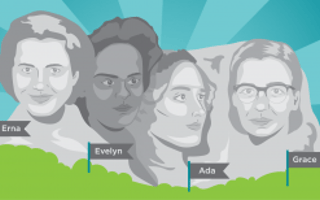By Robyn Jordan
In March, when the members of the New Relic community team (Karissa Peth, Tori Wieldt, Clay Smith, Jackson De Oliveira, and myself) realized we had numerous women-focused events planned for Women’s History Month, we wanted to find a way to highlight the important role women have played in the history of modern technology. So we built “Mount Codemore,” our spin on the famous monument, in which we replaced faces of past U.S. presidents with those of four giants of women’s contributions to science and technology.
We created limited-edition stickers of the Mount Codemore logo to hand out at the Women Who Code conference in Seattle last month. Women Who Code is a nonprofit organization dedicated to inspiring women to excel in technology careers, a mission that New Relic is also passionate about.
It wasn’t easy to decide who belonged on Mount Codemore. We wanted each honoree to embody the diverse and integral role women have played in modern computer technology, from the earliest stages to the tech industry we work in today.
The four women we eventually chose—Grace Hopper, Ada Lovelace, Evelyn Boyd Granville, and Erna Hoover—have all led fascinating and inspirational lives. Read their stories below:

The Pioneer:
Ada Lovelace, Mathematician: 1815–1852
Ada Lovelace is often referred to as the first computer programmer. Born in 1815, she was the daughter of the famed English poet Lord Byron, and from a young age she was encouraged by her mother to study mathematics. Ada was introduced to mathematician Charles Babbage in 1833 and soon after began to help him develop his idea for a general-purpose computer known as the Analytical Engine. While working with Babbage, Lovelace came up with what has been generally thought of as the first computer program. There has been some controversy around how much credit Ada is owed for her work with Babbage, but regardless her legacy lives on, as evidenced by the programming language christened “Ada” developed in 1977 and the numerous movies, plays, books, and even comic books based on her life.
The Celebrity:
Grace Hopper, Computer Scientist: 1906–1992
Grace Hopper is a well-recognized name in technology and arguably the most well-known figure on Mount Codemore. A graduate of Vassar, she received her Master’s and Ph.D. in mathematics from Yale. Hopper was a college professor at Vassar until 1943 when she joined the United States Navy during World War II. She was one of the first programmers to work on the Mark I computer, and is also credited with inventing the first compiler for a computing language. Hopper remained in the Navy until 1986, at the time she was the oldest commissioned officer on active duty. After leaving the service, she continued to mentor young computer programmers, and she is the namesake of The Grace Hopper Celebration of Women in Computing, a popular yearly conference that attracts thousands of women.
The Barrier Breaker:
Evelyn Boyd Granville, Mathematician: 1924–
Evelyn Boyd Granville may not be as well known as the other women of Mount Codemore, but her accomplishments are just as impressive. Evelyn was the second African American woman to earn a Ph.D. in mathematics. She received her degree from Yale in 1949 and began teaching mathematics at Fisk University in 1950 before leaving to join IBM as a computer programmer. She relocated to Los Angeles to work in IBM’s Aviation Space and Information Systems division, where she worked on various projects for the Apollo space program, including digital computer techniques. After IBM she continued to teach mathematics in California and Texas. At the age of 91, she remains active in the field of STEM education. Granville’s portrait can be found in the National Academy of Sciences Portrait Collection of African-Americans in Science.
The Balancer:
Erna Schneider Hoover, Mathematician: 1926–
Erna Hoover is a mathematician credited for inventing telephone switching systems and revolutionizing modern communication. Her invention earned her one of the first patents for computer software and a place in the National Inventors Hall of Fame. She graduated from Wellesley and received her Ph.D. from Yale. She took a post as a logic and philosophy professor at Swarthmore College, but the obstacles she faced in obtaining tenure prompted her to take a job at Bell Laboratories in 1954. While in the hospital recuperating from childbirth, Hoover invented the phone switching system; Bell Labs’ lawyers visited her at home while she was on maternity leave so she could sign the patent papers. Amazingly, the principles used in her patented Feedback Control Monitor for Stored Program Data Processing System are still in use today. After retiring from Bell labs in 1987, she served on the board of trustees for higher education systems and has been instrumental in increasing the number of women faculty members.
Inspiration for future generations
The obstacles faced by the women on Mount Codemore are sadly not so different from what many women in the tech industry still face. We hope the Mount Codemore “Tech Titans” will serve as inspiration for future generations of women hoping to change the world.
We’d love to hear from you. Who else do you think deserves to be commemorated on the face of Mount Codemore? Tweet us your suggestions @NewRelic with hashtag #WomenInTech.
About the Author
Robyn Jordan works at New Relic as the Community Program Manager. She lives in downtown Oakland where she can be found either at Lake Merritt, a neighborhood coffee shop, or Rudy's Can't Fail Cafe eating pancakes. She is an obsessive fangirl who lives for Doctor Who, Marvel, and mostly Harry Potter—she even has a podcast dedicated to the world of Hogwarts. View posts by Robyn Jordan.






